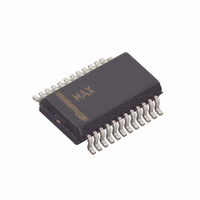MAX1858EEG+ Maxim Integrated Products, MAX1858EEG+ Datasheet - Page 7

MAX1858EEG+
Manufacturer Part Number
MAX1858EEG+
Description
IC CNTRLR BUCK DUAL 24-QSOP
Manufacturer
Maxim Integrated Products
Type
Step-Down (Buck)r
Datasheet
1.MAX1858EEG.pdf
(21 pages)
Specifications of MAX1858EEG+
Internal Switch(s)
No
Synchronous Rectifier
No
Number Of Outputs
2
Voltage - Output
0 ~ 18 V
Current - Output
10A
Frequency - Switching
100kHz ~ 600kHz
Voltage - Input
4.75 ~ 23 V
Operating Temperature
-40°C ~ 85°C
Mounting Type
Surface Mount
Package / Case
24-QSOP
Power - Output
762mW
Lead Free Status / RoHS Status
Lead free / RoHS Compliant
The MAX1858 step-down converters use a PWM volt-
age-mode control scheme (Figure 2) for each out-of-
phase controller. The controller generates the clock
signal by dividing down the internal oscillator or SYNC
input when driven by an external clock, so each con-
troller’s switching frequency equals half the oscillator
frequency (f
error amplifier produces an integrated error voltage at
the COMP pin, providing high DC accuracy. The volt-
age at COMP sets the duty cycle using a PWM com-
parator and a ramp generator. At each rising edge of
the clock, REG1’s high-side N-channel MOSFET turns
on and remains on until either the appropriate duty
cycle or until the maximum duty cycle is reached.
REG2 operates out-of-phase, so the second high-side
MOSFET turns on at each falling edge of the clock.
During each high-side MOSFET’s on-time, the associat-
ed inductor current ramps up.
During the second-half of the switching cycle, the high-
side MOSFET turns off and the low-side N-channel
MOSFET turns on. Now the inductor releases the stored
energy as its current ramps down, providing current to
the output. Under overload conditions, when the induc-
PIN
14
15
16
17
18
19
20
21
22
23
24
Controller with Power Sequencing and POR
SW
= f
NAME
PGND
BST1
BST2
DH1
DH2
LX1
DL1
DL2
LX2
EN
V
OSC
_______________________________________________________________________________________
Dual 180° Out-of-Phase PWM Step-Down
L
/2). An internal transconductance
Detailed Description
High-Side Gate Driver Output for Regulator 1 (REG1). DH1 swings from LX1 to BST1.
External Inductor Connection for Regulator 1 (REG1). Connect LX1 to the switched side of the
inductor. LX1 serves as the lower supply rail for the DH1 high-side gate driver.
Boost Flying-Capacitor Connection for Regulator 1 (REG1). Connect BST1 to an external ceramic
capacitor and diode according to Figure 1.
Low-Side Gate-Driver Output for Regulator 1 (REG1). DL1 swings from PGND to V
Power Ground
Internal 5V Linear-Regulator Output. Supplies the regulators and powers the low-side gate drivers
and external boost circuitry for the high-side gate drivers.
Low-Side Gate-Driver Output for Regulator 2 (REG2). DL2 swings from PGND to V
Boost Flying-Capacitor Connection for Regulator 2 (REG2). Connect BST2 to an external ceramic
capacitor and diode according to Figure 1.
External Inductor Connection for Regulator 2 (REG2). Connect LX2 to the switched side of the
inductor. LX2 serves as the lower supply rail for the DH2 high-side gate driver.
High-Side Gate-Driver Output for Regulator 2 (REG2). DH2 swings from LX2 to BST2.
Active-High Enable Input. A logic low shuts down both controllers. Connect to V
operation.
DC-DC PWM Controller
tor current exceeds the selected valley current-limit
(see the Current-Limit Circuit (ILIM_) section), the high-
side MOSFET does not turn on at the appropriate clock
edge and the low-side MOSFET remains on to let the
inductor current ramp down.
The two independent regulators in the MAX1858 oper-
ate 180° out-of-phase to reduce input filtering require-
ments, reduce electromagnetic interference (EMI), and
improve efficiency. This effectively lowers component
cost and saves board space, making the MAX1858
ideal for cost-sensitive applications.
Dual-switching regulators typically operate both con-
trollers in-phase, and turn on both high-side MOSFETs
at the same time. The input capacitor must then sup-
port the instantaneous current requirements of both
controllers simultaneously, resulting in increased ripple
voltage and current when compared to a single switch-
ing regulator. The higher RMS ripple current lowers effi-
ciency due to power loss associated with the input
capacitor’s effective series resistance (ESR). This typi-
cally requires more low-ESR input capacitors in parallel
to minimize input voltage ripple and ESR-related loss-
es, or to meet the necessary ripple-current rating.
FUNCTION
Synchronized Out-of-Phase Operation
Pin Description (continued)
L
for always-on
L
L
.
.
7











